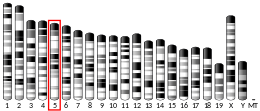Glypican 2
Glypican 2 (GPC2), also known cerebroglycan, is a protein which in humans is encoded by the GPC2 gene.[5][6]
Function
Cerebroglycan is a glycophosphatidylinositol-linked integral membrane heparan sulfate proteoglycan found in the developing nervous system. Cerebroglycan participates in cell adhesion and is thought to regulate the growth and guidance of axons.[7] Cerebroglycan has especially high affinity for laminin-1.[8]
Implications in cancer
GPC2 has been suggested as a therapeutic target in neuroblastoma.[9][10] GPC2 is highly expressed in about half of neuroblastoma cases and that high GPC2 expression correlates with poor overall survival.[9] GPC2 silencing inactivates Wnt/β-catenin signaling and reduces the expression of N-Myc, an oncogenic driver of neuroblastoma tumorigenesis.[9] Immunotoxins and chimeric antigen receptor (CAR) T cells targeting GPC2 inhibit neuroblastoma growth in mouse models.[9] A GPC3 specific antibody drug conjugate (ADC) can also inhibit neuroblastoma cell proliferation.[10]
See also
References
- GRCh38: Ensembl release 89: ENSG00000213420 - Ensembl, May 2017
- GRCm38: Ensembl release 89: ENSMUSG00000029510 - Ensembl, May 2017
- "Human PubMed Reference:". National Center for Biotechnology Information, U.S. National Library of Medicine.
- "Mouse PubMed Reference:". National Center for Biotechnology Information, U.S. National Library of Medicine.
- Stipp CS, Litwack ED, Lander AD (January 1994). "Cerebroglycan: an integral membrane heparan sulfate proteoglycan that is unique to the developing nervous system and expressed specifically during neuronal differentiation". The Journal of Cell Biology. 124 (1–2): 149–60. doi:10.1083/jcb.124.1.149. PMC 2119891. PMID 8294498.
- "Entrez Gene: GPC2 glypican 2".
- Ivins JK, Litwack ED, Kumbasar A, Stipp CS, Lander AD (April 1997). "Cerebroglycan, a developmentally regulated cell-surface heparan sulfate proteoglycan, is expressed on developing axons and growth cones" (PDF). Developmental Biology. 184 (2): 320–32. doi:10.1006/dbio.1997.8532. PMID 9133438.
- Herndon ME, Stipp CS, Lander AD (February 1999). "Interactions of neural glycosaminoglycans and proteoglycans with protein ligands: assessment of selectivity, heterogeneity and the participation of core proteins in binding". Glycobiology. 9 (2): 143–55. doi:10.1093/glycob/9.2.143. PMID 9949192.
- Li N, Fu H, Hewitt SM, Dimitrov DS, Ho M (August 2017). "Therapeutically targeting glypican-2 via single-domain antibody-based chimeric antigen receptors and immunotoxins in neuroblastoma". Proceedings of the National Academy of Sciences of the United States of America. 114 (32): E6623–E6631. doi:10.1073/pnas.1706055114. PMC 5559039. PMID 28739923.
- Bosse KR, Raman P, Zhu Z, Lane M, Martinez D, Heitzeneder S, et al. (September 2017). "Identification of GPC2 as an Oncoprotein and Candidate Immunotherapeutic Target in High-Risk Neuroblastoma". Cancer Cell. 32 (3): 295–309.e12. doi:10.1016/j.ccell.2017.08.003. PMC 5600520. PMID 28898695.
External links
- GPC2+protein,+human at the US National Library of Medicine Medical Subject Headings (MeSH)



